#Tarawa
Explore tagged Tumblr posts
Text

Photo I took of a U.S. Marine BAR gunner charging onto the beach, next to an amphibious assault vehicle, at the Tarawa display, located in the atrium of the National Museum of the Marine Corps in Quantico, Virginia.
This year marks the 81st anniversary of the battle of Tarawa.
121 notes
·
View notes
Text
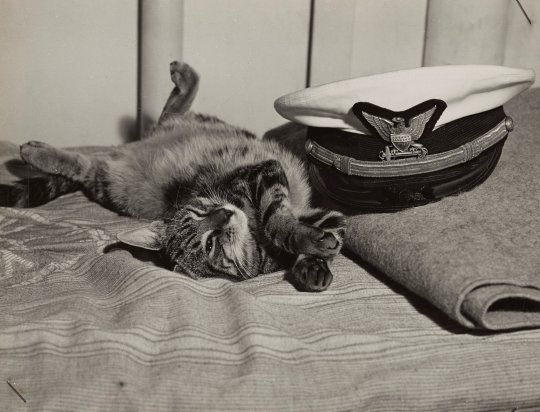
This kitten, nicknamed Tarawa, served briefly as the mascot and Ship's cat on a US Coast Guard tank-landing ship during WW II
318 notes
·
View notes
Text
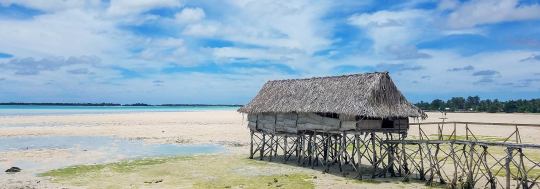
Tarawa, Kiribati
#tarawa#kiribati#ocenia#kiribati is very small so i couldn't find very good pictures#so this is not technically a street#beach#nature#sky#blue#vacation#tourism#travel#dailystreetsnapshots#photography#ocean#places
14 notes
·
View notes
Text


Marines américains à l'assaut de positions japonaises sur l'île de Betio – Bataille de Tarawa – Campagne des îles Gilbert et Marshall – Guerre du Pacifique – Atoll de Tarawa – Iles Gilbert – 21 novembre 1943
#WWII#guerre du pacifique#pacific war#campagne des iles gilbert et marshall#gilbert and marshall islands campaign#bataille de tarawa#battle of tarawa#corps des marines#us marine corps#tarawa#iles gilbert#gilbert islands#21/11/1943#11/1943#1943
10 notes
·
View notes
Text
Donald Trump has a thing. He has lots of things, being a creature made of personality defects, narcissism and high-tensile racism, and who looks like a semi-sentient block of cheese that has somehow gained a rudimentary understanding of fascism, but in this case I’m talking about his thing is to attack the US military of today by valourising two of its past leaders: Douglas MacArthur and George Patton.
"Remember the old days of General MacArthur and General Patton, and these great generals," Trump told CPAC in 2015. "General MacArthur is spinning in his grave when he sees what we do."
He’s also used them to attack his opponents: “[Hillary Clinton] tells you how to fight ISIS on her website… I don't think Gen. Douglas MacArthur would like that very much."
These are two examples among many of something as close to admiration a man like Trump can ever display and it’s easy to see why he picks these men to elevate. Trump is a man given over to the projection of an image, a man who, like many authoritarians, impersonates the man he says he is, not unlike those fraudsters you see in the news from time to time. Tricksters convicted of conning millions out of dumb rich people while pretending to be German nobility. Impression and publicity are the thing, so naturally, not being a well-read man, or one prone to anything but superficiality, Trump would gravitate to the most self-aggrandising, most flawed of America’s military leaders.
Some of Patton’s tough talking character was bluster. Delivered in a characteristically high-pitched voice, his bloodthirsty quotes were often intended to inspire in his men confidence in his leadership and in themselves. But sometimes it was not. In Sicily, he was fired when he slapped men suffering from PTSD, and then again soon after the end of the war in Europe, because he wanted to go to war with the USSR and his absence of political nous meant his superiors had little use for him in peacetime. He never rose to the highest rank. Eisenhower, the great coalition builder and politician, favoured Omar Bradley.
Like many of their ilk, image was key to both – Patton’s cavalry boots and trousers were topped with a ridiculous shiny, polished helmet; MacArthur habitually wore aviator glasses, pipe and leather jacket.
A man of gargantuan ego, MacArthur was obsessed with liberating the Philippines from the Japanese after being defeated there in the early part of the war. He threatened to run against Roosevelt for President in order to get his way and ensure he was given command of vast forces for the task, his famous 1942 declaration of “…I shall return” was followed up with “…I have returned” after landings on Leyte in October 1944 (Never a man who used ‘we’ where ‘I’ could fit, he earned the enmity of men under his command in the first Philippine campaign who nicknamed him Dugout Doug, noting in disgust his insistence in lauding himself in dispatches to the USA and the exclusion of their own sacrifices).
It’s not hard to see why Trump, a man who has a child’s understanding of strength and a perpetual, diseased need to take credit would be attracted to a man who took backhanders from the Philippine government and had a friendly press baron amplifying his voice at home.
(There’s also the less well-known pre-war part of MacArthur’s biography where he, a man in his fifties, took a sixteen-year-old Filipina as his mistress, which Trump, a rapist, would surely see as unproblematic if he ever learned of it).
To be clear, both Patton and MacArthur were highly competent, knowledgeable and precise, and responsible for extraordinary victories in Europe and Pacific, but both were massively flawed characters, and neither were in the top tier of American commanders. It’s emblematic of Trump’s character that he would gravitate to the egotistic, meddling MacArthur ahead of Chester Nimitz, architect of the Navy’s drive through the Central Pacific, which got underway in earnest on the 20th of November 1943 with landings on Betio and Makin Atolls, Tarawa.
The land campaigns of the Pacific all have their own unique, awful characteristics. There are the battles over the Kokoda Trail, fought in the mountain forests of New Guinea. The jungles and rain of the Solomons campaign. The heat of Peleliu, where bad Marine leadership threw men uselessly against Japanese fortifications dug into the rock caves in the centre of the island. The massive numbers of civilian dead of Saipan and Okinawa, often victims of murder-suicides – Japanese, taught to fear the American and to never be taken captive killed themselves and/or their families in terrible numbers. (There is colour film of people throwing themselves to their deaths from the cliffs of northern Saipan.) And the sulphuric rock of the volcanic Iwo Jima, the only battle where US casualties outnumbered Japanese.
On Tarawa, a stereotypical Pacific Island of sand and palm trees, there was a beautiful tropical lagoon.

Betio Atoll, lying 2,400 miles southwest of Hawai’i is a tiny island that today is part of Kiribati, but it was not quite small enough for war to pass it by, for it was the right shape and just big enough for the Japanese to build an airfield on it. And so, to protect their supply lines from interdiction during the campaign westward, the Americans decided it must be seized and assembled a fleet of 191 ships to transport and support a force of 35,000 troops to attack it.
GALVANIC, as the operation was designated, was unknown territory. Amphibious landings had been done at Guadalcanal and throughout the Solomons, for Operation TORCH in North Africa, and recently HUSKY, BAYTOWN and AVALANCHE in Sicily and Italy. But none of these had been against heavily fortified defences of the type the Japanese, well aware of their vulnerability, had built. Tarawa had a garrison of about 5,000 men, half of whom were Rikusentai – the Special Naval Landing Forces that were the Imperial Japanese Navy’s equivalent of Marines. The rest were construction crews and engineers, and they made a complex of bunkers, pillboxes and trenches, reinforced with concrete, timber and coral that proved enormously difficult to reduce.
While the Americans had studied and planned for the kind of opposed landings they would now attempt, there was no proof of concept and, worse, they were short of vital resources.
A year previously, the US Navy had contested control of the Pacific with two operational aircraft carriers. Now, in the autumn of 1943, its industry had built a fleet of Essex- and Independence-class carriers that came to dominate the rest of the war. One day, during the two-week voyage from New Zealand to Tarawa, a crewman on the USS Saratoga counted 13 different carriers among the fleet. But they were sorely lacking in landing craft.
The landings in Italy had already suffered from this shortage – both BAYTOWN and AVALANCHE had been allocated far fewer landing craft than they needed and now GALVANIC would. They were desperately short of the LVTs – amphibious tractors – which would carry the first wave of Marines onto the invasion beaches. They had cannibalised older vehicles that had been used on Guadalcanal and welded makeshift armour to others they acquired. But the following waves rode in Higgins boats – the classic, familiar-looking assault craft from movies like Saving Private Ryan. These craft would never reach shore.
The invasion coincided with Tarawa’s neap tide and while many of the people the Navy consulted about the depth of water in the lagoon opposite the invasion beaches were confident about the depth of water they would find, there was no consensus. One man, a New Zealander named Major F L G Holland warned that there would be less than 3 feet of water over the coral reef that bordered the lagoon. He was right. The tracked amtracs of the first wave could grind their way over the reef and into the lagoon, but the Higgins boats following hit it and the invasion stalled.
Men were disgorged into the water at the reef and had to wade through chest and neck-deep water to get to shore. Some transferred to amtracs that took them halfway before being told that it was too dangerous for the amtrac to go further, that the diminshing number of amtracs were too valuable to risk and that they would have to trek through the maelstrom of fire that the lagoon had become. Men struggled past the dismembered and mutilated bodies of their comrades, the burning disabled wrecks of craft that had made it into the lagoon, through water turned crimson with blood, alongside the floating corpses of thousands of tropical fish killed by the concussion of hundreds of explosions to reach a beach where the tempest of the lagoon was replaced by a world of sand, blood and slaughter.
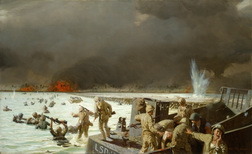
On land, the marines found themselves against a sea wall made of timber and beneath this were able to regroup. Communications were difficult. The few senior officers on the scene found that many radios were lost, or so waterlogged as to be ineffective. The battle had little direction, devolving into small groups of marines led by lieutenants, NCOs and privates slowing creeping inland, clearing bunkers as they went. Sometimes they were forced back, sometimes they held on to the territory they took. Always they took grievous losses.
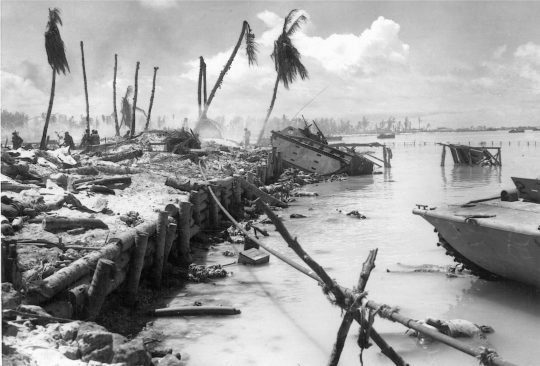
Things were no better on the Japanese side, for early on the first day, the garrison commander, Rear Admiral Shibasaki Keiji was killed.
Artillery fire is a terrible thing to be under, naval gunfire orders of magnitude worse. The standard 105mm M2 howitzer used by the US army fired a 40lb shell. The battleships USS Maryland and Colorado which bombarded Betio fired 16-inch shells that weighed 2,100lbs. A broadside from either sent more than seven and a half tons of high explosive at a target up to 14 miles away. Combined with fire from cruisers and destroyers the pre-invasion bombardment killed perhaps 40% of the island’s defenders, wrecked much of its defences, and - because wires could not be buried deeply enough in the sand of Betio - destroyed its telephone network. Shibasaki, frustrated at his inability to communicate with his men decided to move his command post and, out in the open, was killed along with his entire staff when a 5-inch shell from an American destroyer landed in the middle of them. Whatever was left of his body was never recovered.
In this, the Americans were lucky. Their position on the first day was precarious and Shibasaki’s death meant the Japanese defence became uncoordinated and prevented them from mounting a counterattack on the first night. They did sneak men onto the wreck of a freighter in the lagoon, from where they continued to rake it with fire. Strikes by aircraft on the freighter were inaccurate and often hit US troops. Friendly fire from both air and sea would be a problem throughout the battle for American forces.
The Marines, with few of the flamethrowers and bazookas they would have in later battles, reduced the island pillbox by pillbox, often having to silence them multiple times as Rikusentai reoccupied firing positions thought eliminated by means of hidden trenches. The long wooden pier leading out into the lagoon would be the source of constant fire throughout the battle.
It took 76 hours to take Tarawa. Slightly over three days of small unit fighting, men rushing firing positions and pouring grenades and bullets through openings. Frontal attacks against pillboxes, or flanking attacks that exposed men to fire from another position in overlapping network of defence. Tanks, immobilised by mine or Japanese fire would provide support, but mostly this was a battle fought by the infantry at short range with rifle, sub-machine gun and grenade. At the end of it, 1,009 Marines of the 2nd Division had been killed and another 2,101 wounded - roughly 25% of the men landed on the island.
687 more men were killed when the relatively small escort carrier USS Liscome Bay was torpedoed by a Japanese submarine off Makin. The torpedo detonated her magazine, and the resulting explosion blew her in half. The fireball rose a thousand feet in the air and debris fell on ships miles away.
Of the Japanese garrison of nearly 5,000, 146 survived, 129 of whom were Korean construction labourers. The rest fought to the death, or were simply denied the opportunity to surrender, the Americans having learned on Guadalcanal that Japanese would often feign surrender in order to lull their enemies and kill them with bayonet or grenade.
Life Magazine published photos of American dead floating in the surf of Tarawa, washed up on the beaches of Betio. The journalist Robert Sherrod, who had been on a Higgins boat and waded through the lagoon on the first morning wrote detailed dispatches for Time. The American public were shocked by the bloodbath on the atolls of Tarawa. One New York paper declared that the US should have used poison gas. Nimitz received letters from bereaved families. “You killed my son on Tarawa,” a mother wrote. Nimitz read each of them and answered them personally, considering it his responsibility. The burden of command.
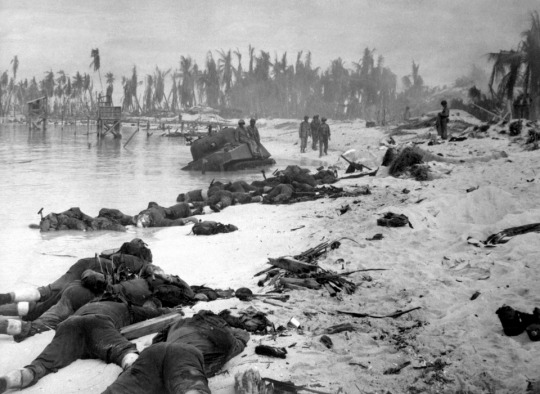
The Japanese were told the defenders had been overwhelmed, but at such a cost to the Americans that it was to all intents a victory for the Japanese Empire, a lie habitually told after defeats. Midway had been a great victory in their press.
Lessons were learned. Coordination between US land, sea and air forces improved. Invasion troops carried less unessential equipment and more ammunition and explosives. They learned to rely on supply from the sea. Future invasions had more amtracs available, of improved design, with more armour and more firepower. Napalm was introduced and used in staggering amounts, dropped from plane and shot from tanks to incinerate bunker and cave and kill the defenders within.
Japanese strategy leaned on the assumption that the Americans would not have the stomach for the fight. That the American public would not support the casualties needed to defeat them. They were wrong. Before long, papers in the US were warning of the need for America to steel itself, for Tarawa was a foreshadowing of future battles, on larger islands closer to the Japanese homeland. That the tiny, blood-soaked atolls of Tarawa heralded unprecedented carnage and butchery.
In this, they were right.

#ww2#world war 2#war is fucking awful#however bad you've imagined war to be it is much much worse#tarawa#wwii
6 notes
·
View notes
Text
With the Marines at Tarawa
#Tarawa#kiribati#marines#us national archives#wwii#us navy#Best Documentary#Short Subjects#oscar#1945
0 notes
Text

A U.S. Marine holds his M1 Carbine while making a radio transmission during the Battle of Tarawa, November 1943.
103 notes
·
View notes
Text
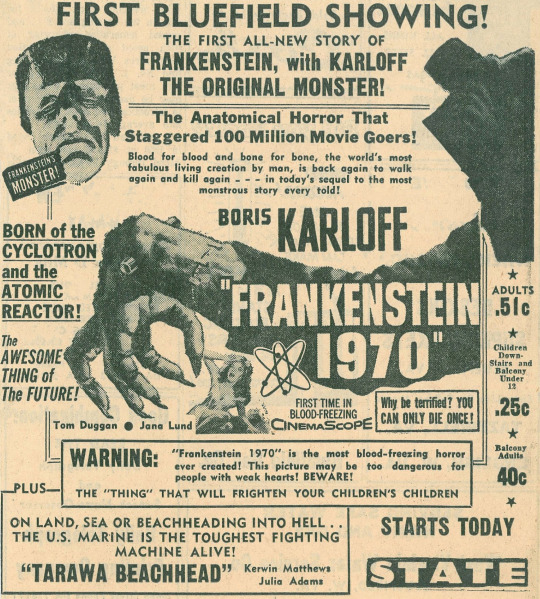
Frankenstein 1970 (1958) & Tarawa Beachhead (1958)
#frankenstein 1970#boris karloff#horror#tarawa beachhead#war drama#1950s movies#double feature#howard w. koch#1958#vintage movie ads
177 notes
·
View notes
Text
Art of War (8)

Hot Sand (1944) - Harry A. Jackson (1924-2011) [United States of America]
Mixed Media
[Image Description. A group of American soldiers are gathered together before a sand tunnel, boxed in by meager barricades. One preps a grades. On each side of him are soldiers partially laying down, using the guns' bipods. Behind them a soldier holds his receiver to his face. On his back is the tall radio antennae. Closer to the camera is a wounded soldier. He has no helmet, and his legs are coated in bandages that have been soaked through with blood.
They are all surrounded by a sandy landscape. A crate is half buried in the foreground. The background includes a cloudy sky dusted by kicked up sand, and broken leafless trees. End ID.]
This piece captures a scene from the Battle of Tarawa (1943) in Japan during WW2. The artist, Harry A. Jackson, was wounded during the battle. He suffered from epileptic seizures and PTSD for the rest of his life, but he continued to create even after being honorably discharged while being a combat artist. His art journey took many different directions, from experimenting with abstract expressionism to sculpting.
Can be seen now in-person at the United States Marine Corps Museum
#united states#art history#war art#ptsd#1940s#1944#battle of tarawa#japan#us history#ww2#ww2 art#antiwar#united states history
2 notes
·
View notes
Text



USS TARAWA (CV-40) in the New York Group, Atlantic Reserve Fleet at Bayonne Navy Yard, New Jersey. She was decommissioned on June 30, 1949 and recommissioned for the Korean War on February 3, 1951. TARAWA served for 9 more years before being decommissioned on May 13, 1960. She was sold for scrap in 1968.
In the background of the second photo is USS NEW JERSEY (BB-62).
Date: February 2, 1950
Photographed by Herbert Gehr, LIFE Magazine.
LIFE Magazine Archives: 111458573, 111458552, 111458560
#USS Tarawa (CV-40)#USS Tarawa#Essex Class#Aircraft Carrier#USS New Jersey (BB-62)#USS New Jersey#Iowa Class#Battleship#warship#ship#February#1950#post war#Bayonne Navy Yard#New Jersey#Reserve Fleet#east coast#mothballs#united states navy#us navy#navy#usn#u.s. navy#my post
27 notes
·
View notes
Text
youtube
#youtube#militarytraining#tow#salvage team#USS Tarawa#US Navy#naval operations#salvage operation#rescue#naval salvage#Navy salvage#recovery#shipwreck#maritime#military salvage#ship salvage operation#naval vessels#salvage operation footage#salvage#salvage operation video#naval ship#towing#Salvage mission#Mission#Tow#Military#Epic#Navy#Ship#Rescue
1 note
·
View note
Text

A moment of compassion, during hell on earth.
U.S. Marine and combat cameraman Norman Hatch, gives a drink of water to a kitten who was hiding under a destroyed Japanese tank, during the battle of Tarawa on November 23, 1943.
(Photo courtesy of USMC)
140 notes
·
View notes
Text

In August of 1943, pilots clamber out of the cockpits of their Douglas Dauntless aircraft aboard the USS Lexington, following a raid on Tarawa. ✈️
@jasonrburt via X
207 notes
·
View notes
Text




An F9F-6 of VF-73 makes a poor landing a catches the barrier aboard USS Tarawa (CVA-40) during carrier qualifications, December 1954
99 notes
·
View notes
Text
John Kinsel Sr., one of the last remaining Navajo Code Talkers who transmitted messages during World War II based on the tribe’s native language, has died. He was 107. Navajo Nation officials in Window Rock announced Kinsel’s death on Saturday. Tribal President Buu Nygren has ordered all flags on the reservation to be flown at half-staff until Oct. 27 at sunset to honor Kinsel. “Mr. Kinsel was a Marine who bravely and selflessly fought for all of us in the most terrifying circumstances with the greatest responsibility as a Navajo Code Talker,” Nygren said in a statement Sunday. With Kinsel’s death, only two Navajo Code Talkers are still alive: Former Navajo Chairman Peter MacDonald and Thomas H. Begay. Hundreds of Navajos were recruited by the Marines to serve as Code Talkers during the war, transmitting messages based on their then-unwritten native language. They confounded Japanese military cryptologists during World War II and participated in all assaults the Marines led in the Pacific from 1942 to 1945, including at Guadalcanal, Tarawa, Peleliu and Iwo Jima. The Code Talkers sent thousands of messages without error on Japanese troop movements, battlefield tactics and other communications crucial to the war’s ultimate outcome.
82 notes
·
View notes
Text


A large crowd lines the pier at an unidentified port to visit USS Tarawa (CVA-40) during her World Cruise, 12 November 1953–6 September 1954, with embarked Carrier Air Group (CVG) 3. NNAM
21 notes
·
View notes